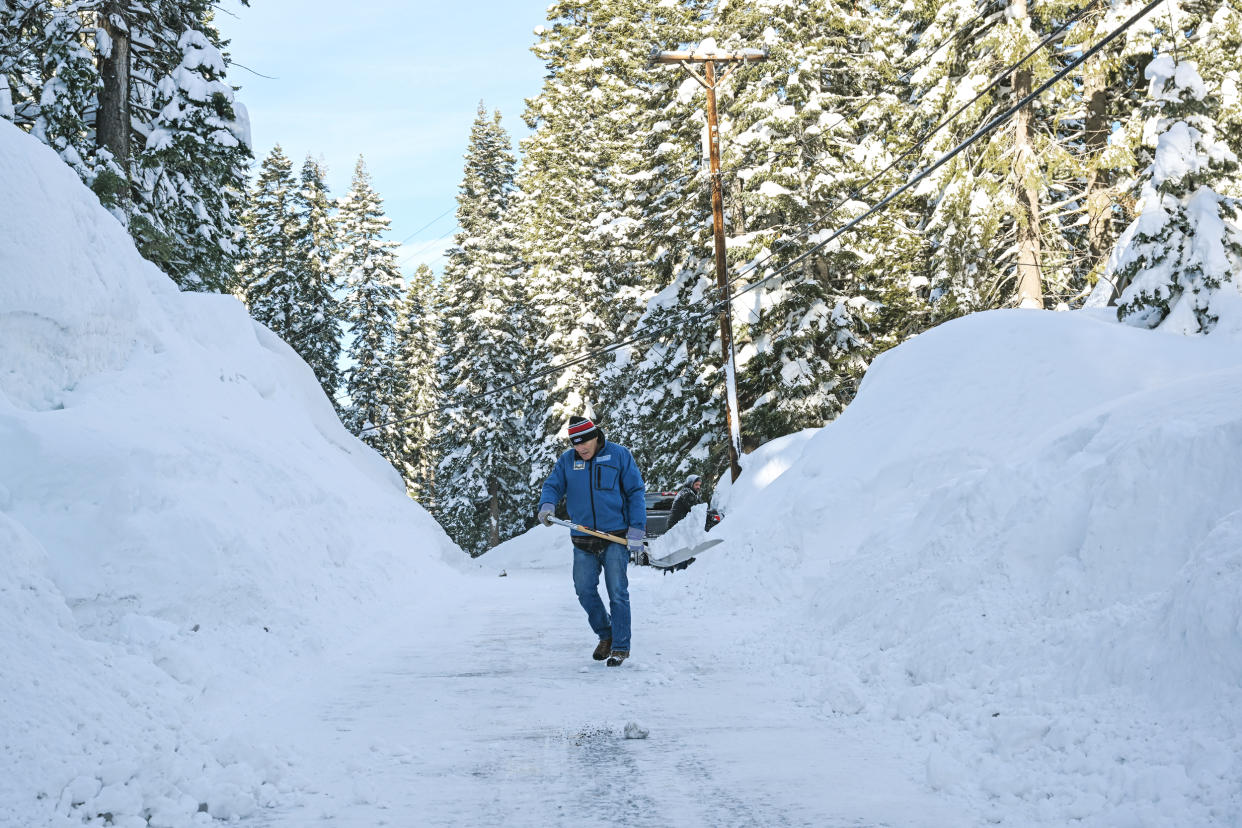'Potent' winter storm expected to bring heavy snow and rain to the Midwest and New England
Thousands across Texas are waking up Friday morning without power following a night of tornado sirens and heavy winds, as a "potent" winter storm is expected to bring heavy snow from the Upper Midwest through New England this weekend.
More than 170,000 homes and businesses were left without power across Texas on Thursday night after severe weather struck parts of the state and others, the Texas utility Oncor said.
As of early Friday, power had been restored to some, with at least 110,000 utility customers still facing outages.
Tornadoes reported in multiple counties
Tornado sirens sounded in Dallas and other parts of Texas on Thursday, and high winds overturned multiple tractor-trailers, officials said. No deaths had been immediately reported.
Tornadoes were reported in Franklin and Hopkins counties in Texas, which are east of Dallas, and in the Shreveport, Louisiana, area, the National Weather Service said.
Storm surveys are being done to confirm whether reported tornadoes actually occurred.
Tornado watches covered around 3.5 million people in Texas and the South on Thursday night, according to the weather service. The watches stretched from east of Dallas into Arkansas and northern Louisiana.
By early Friday, watches had expired for Texas but tornado watches covered northern Louisiana, large parts of Missouri and into Mississippi. The storm was forecast to move into the Ohio and the Tennessee valleys Friday and then continue northeast, the weather service said.
Louisiana State University Shreveport suffered minor damage after a storm hit around 5:45 p.m. There were no injuries, but the winds were powerful enough that two shipping containers parked in a campus parking lot were moved, university Communications Director Erin Smith said.
The weather service in Shreveport said it would investigate possible damage in the region to see whether tornadoes had developed. Video shared by the agency appeared to show one in Shreveport.
NBC Dallas-Fort Worth reported that its crews spotted five overturned tractor-trailers on highways north and east of Dallas.
Parts of California buried under snow
The high and damaging winds in parts of the southern United States occurred as mountainous areas of Southern California remained buried under several feet of snow that has trapped people, authorities there said.
Gov. Gavin Newsom has declared a state of emergency for 13 counties, and the San Bernardino County Sheriff’s Office said ready-to-eat meals would be flown by helicopter to affected communities. The California National Guard said Thursday that a UH-60 Blackhawk was being sent to help.
“We know that roofs are starting to collapse,” Dawn Rowe, chair of the San Bernardino County Board of Supervisors, whose district includes some of the hardest-hit areas, said Wednesday.
Around 10 feet of snow fell in some of the mountain communities in the county, which is east of Los Angeles, the county fire department said.
Plowing was being done around the clock to try to clear roads, said the California Department of Transportation, known as Caltrans.
County Fire Chief Dan Munsey said Wednesday that the fire department had responded to almost 100 calls for rescue.
The weather service said the snow total for Snow Valley in the San Bernardino Mountains was 120 inches, or 10 feet, from Feb. 22 to Wednesday. In Crestline, where a grocery store roof collapsed this week, it was 91 inches.

'This storm kind of kept coming'
Andrew Braggins, 43, told The Associated Press that the ceiling in his kitchen in Crestline began to bow from the weight of all the snow, prompting him to shovel his roof — where 5 feet had accumulated.
“I’ve got friends just a few roads away, and they’ve been without power for days,” he said. “You can stock up for a storm. But this storm kind of kept coming.”
Some regions now 'free of drought'
While the recent severe weather has caused chaos for many, central California’s Sierra Nevada and foothills are now "free of drought and abnormal dryness for the first time since January 2020," according to a new report released by the U.S. Drought Monitor.
“The rain has improved California soil moisture and streamflow levels, while the snow has increased mountain snowpack to much above-normal levels,” it said. “Abnormal dryness and moderate to severe drought were contracted across much of California to reflect the above-normal precipitation of recent months, above-normal snowpack, and improved reservoir levels.”
Meanwhile, abnormal dryness and moderate to extreme drought were also eased in Montana, New Mexico and Utah, while abnormal dryness and moderate drought were pulled back in Arizona, the report said.
'Potent' storm to bring weather hazards
Meanwhile, a "potent system" was forecast to produce a "multitude of weather hazards" throughout the eastern third of the country Friday and Saturday, the weather service said.
The storm was expected to rapidly deepen as it approaches "all-time record low sea level pressure values for portions of the Ohio and Missouri valleys," it said.
"The ongoing severe weather and flash flood risk associated with the system will continue through the early Friday morning hours across the Lower Mississippi Valley, with the threat shifting northeastward throughout the day as the strengthening low lifts northward into the Ohio Valley," the weather service warned.
Thunderstorms were also expected to have the potential to produce damaging wind gusts, as well as small hail and the possibility of isolated tornadoes Friday, prompting the weather service's Storm Prediction Center to issue an enhanced risk of severe thunderstorms warning for eastern parts of the Tennessee Valley.
The weather service also warned of the possibility of flash flooding throughout much of the mid-Mississippi and the Ohio valleys, as well as eastward into the mid-Atlantic. A moderate risk of excessive rainfall was possible in parts of northeastern Arkansas, southeastern Missouri, southern Illinois and southern Indiana, it said.
